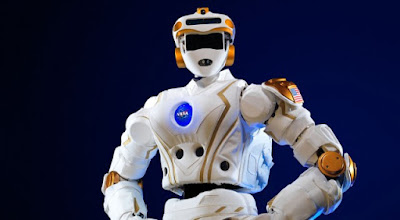MIT AND NORTHEASTERN UNIVERSITY WILL TEST NASA’S
HUMANOID ROBOTS FOR FUTURE SPACE MISSIONS !!!
NASA is gearing up for a new push in human spaceflight with the development of the Orion crew vehicle and Space Launch System. Launching humans into space allows missions to be much more flexible and detailed than a solely robotic one, but there are still times you might prefer to put a robot at risk rather than a human. That’s why NASA has been interested in humanoid robots in recent years. To get ready for the day when humans and robots will team up, the agency has awarded advanced prototype automatons to two universities to conduct research.
The robot on its way to college is known as R5 or “Valkyrie.” It stands 6 feet tall and weighs in at a hefty 290 pounds. The design is not entirely new — you might remember Valkyrie from its appearance in the DARPA Robotics Challenge in late 2013. It has an undeniable superhero aesthetic, complete with glowing NASA logo on the chest. Valkyrie was originally designed for disaster relief missions, so the designs need to be extensively tested for a future in space.
MIT and Northeastern University in Boston will be getting a Valkyrie prototype as part of the program. NASA spent months evaluating proposals from various institutions before deciding on these two. Both teams will receive a grant of $250,000 per year to fund research into how a humanoid robot would work in space. Research will cover virtual simulations of humanoid robots and physical demonstration of advanced tasks using the supplied robots.
Research will explore how a humanoid robot might be able to operate on its own, in preparation for human arrival, and in cooperation with human astronauts. A humanoid body plan isn’t necessarily the most efficient for a robot in general, but it comes with the fewest complications when humans are involved in the same mission. If a robot is shaped like a person, it can use all the same instruments and equipment as a human. Something as simple as a door might have to be redesigned to accommodate a robot that has wheels or treads, but a humanoid robot can just use the same door astronauts use.
Among other things, the researchers will have to create better software to give the robots more autonomy and dexterity. Valkyrie is outfitted with a plethora of sensors including LIDAR, sonar, and cameras in the head, chest, hands, knees, and feet. The challenge will be making use of all that data to allow the robot to handle the details on its own. You want to be able to tell the robot to pick up a tool, not “open fingers, lift arm 20 degrees, straighten elbow, close fingers,” and so on. Robots like Valkyrie could one day be the vanguard of human exploration of Mars and beyond, so they need to be ready for anything.


Comments
Post a Comment